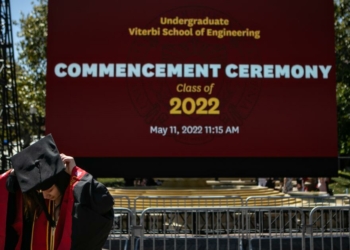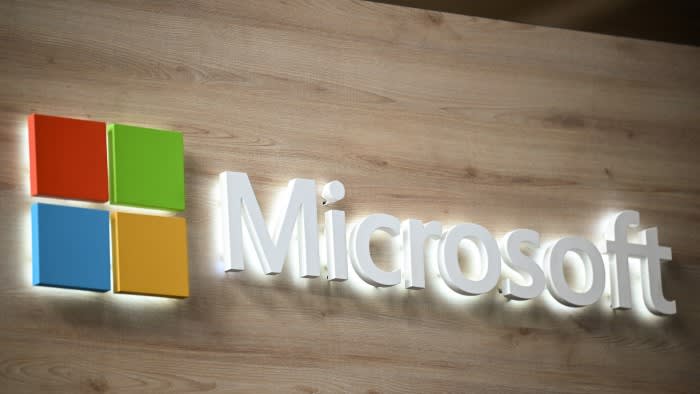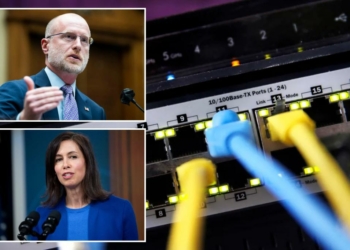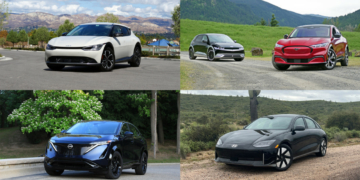
Hard optimization problems can be expressed as interacting networks of probabilistic bits. Efficient solution of these problems require making them less dense at the expense of more p-bits. Credit: UC Santa Barbara
The rise of artificial intelligence (AI) and machine learning (ML) has created a crisis in computing and a significant need for more hardware that is both energy-efficient and scalable. A key step in both AI and ML is making decisions based on incomplete data, the best approach for which is to output a probability for each possible answer. Current classical computers are not able to do that in an energy-efficient way, a limitation that has led to a search for novel approaches to computing. Quantum computers, which operate on qubits, may help meet these challenges, but they are extremely sensitive to their surroundings, must be kept at extremely low temperatures and are still in the early stages of development.
Kerem Camsari, an assistant professor of electrical and computer engineering (ECE) at UC Santa Barbara, believes that probabilistic computers (p-computers) are the solution. P-computers are powered by probabilistic bits (p-bits), which interact with other p-bits in the same system. Unlike the bits in classical computers, which are in a 0 or a 1 state, or qubits, which can be in more than one state at a time, p-bits fluctuate between positions and operate at room temperature. In an article published in Nature ElectronicsCamsari and his collaborators discuss their project that demonstrated the promise of p-computers.
“We showed that inherently probabilistic computers, built out of p-bits, can outperform state-of-the-art software that has been in development for decades,” said Camsari, who received a Young Investigator Award from the Office of Naval Research earlier this year.
Camsari’s group collaborated with scientists at the University of Messina in Italy, with Luke Theogarajan, vice chair of UCSB’s ECE Department, and with physics professor John Martinis, who led the team that built the world’s first quantum computer to achieve quantum supremacy. Together the researchers achieved their promising results by using classical hardware to create domain-specific architectures. They developed a unique sparse Ising machine (sIm), a novel computing device used to solve optimization problems and minimize energy consumption.
Camsari describes the sIm as a collection of probabilistic bits which can be thought of as people. And each person has only a small set of trusted friends, which are the “sparse” connections in the machine.
“The people can make decisions quickly because they each have a small set of trusted friends and they do not have to hear from everyone in an entire network,” he explained. “The process by which these agents reach consensus is similar to that used to solve a hard optimization problem that satisfies many different constraints. Sparse Ising machines allow us to formulate and solve a wide variety of such optimization problems using the same hardware.”
The team’s prototyped architecture included a field-programmable gate array (FPGA), a powerful piece of hardware that provides much more flexibility than application-specific integrated circuits.
“Imagine a computer chip that allows you to program the connections between p-bits in a network without having to fabricate a new chip,” Camsari said.
The researchers showed that their sparse architecture in FPGAs was up to six orders of magnitude faster and had increased sampling speed five to eighteen times faster than those achieved by optimized algorithms used on classical computers.
In addition, they reported that their sIm achieves massive parallelism where the flips per second—the key figure that measures how quickly a p-computer can make an intelligent decision—scales linearly with the number of p-bits. Camsari refers back to the analogy of trusted-friends trying to make a decision.
“The key issue is that the process of reaching a consensus requires strong communication among people who continually talk with one another based on their latest thinking,” he noted. “If everyone makes decisions without listening, a consensus cannot be reached and the optimization problem is not solved.”
In other words, the faster the p-bits communicate, the quicker a consensus can be reached, which is why increasing the flips per second, while ensuring that everyone listens to each other, is crucial.
“This is exactly what we achieved in our design,” he explained. “By ensuring that everyone listens to each other and limiting the number of ‘people’ who could be friends with each other, we parallelized the decision-making process.”
Their work also showed an ability to scale p-computers up to five thousand p-bits, which Camsari sees as extremely promising, while noting that their ideas are just one piece of the p-computer puzzle.
“To us, these results were the tip of the iceberg,” he said. “We used existing transistor technology to emulate our probabilistic architectures, but if nanodevices with much higher levels of integration are used to build p-computers, the advantages would be enormous. This is what is making me lose sleep.”
An 8 p-bit p-computer that Camsari and his collaborators built during his time as a graduate student and postdoctoral researcher at Purdue University initially showed the device’s potential. Their article, published in 2019 in Naturedescribed a ten-fold reduction in the energy and hundred-fold reduction in the area footprint it required compared to a classical computer. Seed funding, provided in fall 2020 by UCSB’s Institute for Energy Efficiency, allowed Camsari and Theogarajan to take p-computer research one step further, supporting the work featured in Nature Electronics.
“The initial findings, combined with our latest results, mean that building p-computers with millions of p-bits to solve optimization or probabilistic decision-making problems with competitive performance may just be possible,” Camsari said.
The research team hopes that p-computers will one day handle a specific set of problems, naturally probabilistic ones, much faster and more efficiently.
‘Poor man’s qubit’ can solve quantum problems without going quantum
Navid Anjum Aadit et al, Massively parallel probabilistic computing with sparse Ising machines, Nature Electronics (2022). DOI: 10.1038 / s41928-022-00774-2
Provided by
University of California – Santa Barbara
Citation:
The potential of p-computers (2022, June 13)
retrieved 23 June 2022
from https://techxplore.com/news/2022-06-potential-p-computers.html
This document is subject to copyright. Apart from any fair dealing for the purpose of private study or research, no
part may be reproduced without the written permission. The content is provided for information purposes only.














